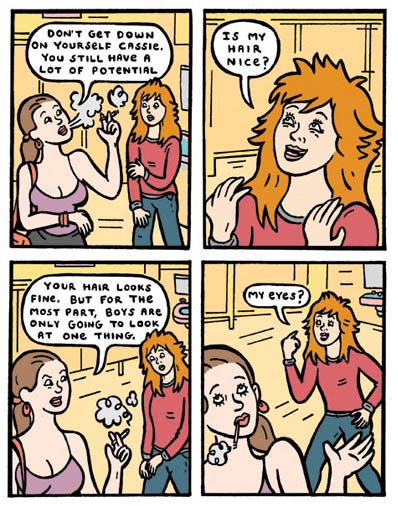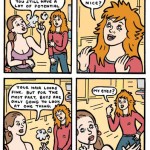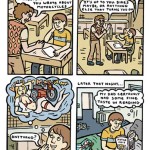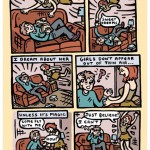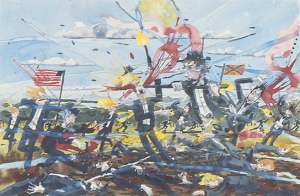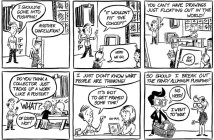DIRTBAGS, MALLCHICKS & MOTORBIKES: A CONVERSATION WITH DAVE KIERSH
Dave Kiersh is an illustrator/ writer/ artist currently living in Arlington, MA. Among other things, he exhibited last year in a group show at Space 242 in Boston. More recently, he was awarded a grant by the Xeric Foundation for his newly released, all-color, 140 page comic book Dirtbags, Mallchicks & Motorbikes which can be purchased via PayPal through his website www.teenagepulp.com. More work of his can be found at davekcomics.com.
DO: Your highly personal comics tend to deal with adolescent awkwardness as in "Never Land" in which the main character, who lives in his parents' basement is kind of stuck in that time like Peter Pan. What makes the teenage years such ripe territory for you from a storytelling standpoint?
DK: That's a good question. There are two types of comics that I tend to draw: fictional comics and a more expressionistic comic, which is not so much fiction as it is a fantasized expression of certain gut feelings. The latter comes more natural to me; this is what I'm inclined to do. This form of expression is an attempt for me to figure out stuff I may be struggling with. This includes themes such as fitting in as an adult, relationships and finding a place in the world. It's harder for me to write fiction but I generally find the challenge more rewarding. The kind of stories I enjoy usually involve teenagers. I'm thinking of things like certain afterschool specials, made-for TV dramas, and Young Adult novels. Sometimes when I tell this to people, they think I am being ironic, but I'm not. For example, I'll pretty much read any sort of fiction that deals with teen pregnancy in some way. In my new book a boy is forced into the responsibility of his girlfriend having a baby. I still can relate to such difficult and sometimes desperate situations. As a 30 year old, I often want to be responsible, but certain factors and situations deny me this capacity. To me, stories with teenagers are more potent, because most likely they are facing such serious dilemmas for the first time.
DO: A lot of your dialogue is poetic, especially when characters have an inner monologue as in "Never Land" when the main character says "I want a castle in the sky, but can we start with something more simple?" or in your web comic "Welcome Home Brave" in which the main character says "My family is not without money/ Dad owns a shop that sells trinkets/ for tourists/ somehow, I want more". Is poetry something you have in mind when you write your dialogue?
DK: Well, I'm not so much a poetry reader in the traditional sense. I do however enjoy music, of course, which is closely related. My early comics were much shorter and with them, I was more concerned with conveying an emotion; story was not so important to me. Even with my longer stories, I have no aspiration for writing a sort of literary graphic novel. When I think of rock and roll songs I like, sometimes they tell a story. But more often what makes them memorable is that they possess a sort of compact nostalgic thrill. Just like an album has a theme that ties songs together, I wanted to create a book of short stories tied together with a common purpose. That's what works for me now, rather than to write a long novel. It's like asking a rock musician to write a song that is an hour long. In that way, it doesn't make sense for me to make a 100 page novel. It has to be interesting for the reader and in doing so avoid repetition. My new book is five short stories not directly related to one another, but you could also view it as one story through the separate characters.
DO: Your drawing style is very distinct: heavy lines and careful cross-hatching with an interesting push and pull between the characters and the background. With the comic pages, but also with your larger drawings like the ones on display last year at Space 242 in Boston I was really taken with how intricate your drawings are on close inspection. Can you describe your process a little?
DK: Sure. For me, the style of drawing changes to some extent depending on how it is going to be reproduced. When I first started about 10 years ago, I was making xeroxed booklets. For this means of production a scratchy line worked well for me. Style changes over time. I am more inclined to post things on the internet now than to go to Kinkos. So now I tend to work with my drawing more directly on the computer. With this method, I usually end up creating a bolder, less scratchy, line. Color became more important to me to this extent, because I am creating color directly on the computer. Making comics is a very deliberate process in that I have to plan out what I am doing. I know what the final page will look like either in my head or with sketches. It can be artistically restrictive, so the larger drawings are experiments in that they are not as planned.
DO: Which leads to my next question, how has learning all that newfangled computer stuff affected your color sense?
DK: I have no great painterly color sense in that my colors have always been flat At first I resisted the computer. But eventually I found that my style lends itself to the technology. It works for me as I have never been a great lover of art supplies, studio spaces and so on. My colors aren't bold; they intentionally look faded like Fall colors or colors from 1970's movies. A dulled color. My images are cartoony and my line is getting rounder so at first glance it can look like a children's book but once the reader notices the faded colors, there's less of a comparison there.
DO: Now you are putting out the new book that you are self publishing with the help of a Xeric grant. There is a preview on your website for those that are interested. We've already talked a little about this, but what is the new book going to be about?
DK: Its called DIRTBAGS, MALLCHICKS & MOTORBIKES and its made up of five different stories. In brief, the first one is about a boy with a learning disability. His problems embarrass him when he becomes attracted to a live-in nurse that is caring for his mother. The second story is about two girls at a mall who get into trouble shoplifting. The third is about a young female tennis player who is pressured to succeed from her parents and rebels. The fourth is about a house party where a boy refuses the come-ons of a popular girl. The fifth story is about a boy who has to decide what kind of father he is going to be to his pregnant girlfriend's baby. That is just a general overview. I hope the larger themes within the book will appear once read.
DO: You are in some way responsible for Drawn and Quarterly publishing SKITZY by the late Don Freeman last year which includes an essay written by you about Freeman's work. How did you come across his work originally and how did SKITZY's publication come about?
DK: I mainly became interested in Don Freeman when I worked as a children's librarian. He and Syd Hoff are the two illustrators with the biggest influence on my drawing. Even though my work looks nothing like them! They are terrific storytellers who meld text and pictures in such a way that reads with such ease. I tend to get obsessive with my interest in authors. For example, my longest fascination of this sort has been with the (writer/artist) Kin Platt. I wrote to him when he was alive and contacted his son after Platt died. Don Freeman is a similar situation. I found his son who had made a website with his father's work that included an excerpt from Skitzy. I suggested that he try getting it published through Drawn and Quarterly. It had been self-published before by Freeman over 50 years ago at the same time he was self publishing a magazine called Newsstand. Newsstand was a way for him to distribute the many lithographs and drawings he created of street life in New York City. I suppose what I appreciate about Freeman, or even Kin Platt, is that they are storytellers who are able to strip a story down to its bare essentials; there's no unnecessary stuff. There is a rhythm to their stories, the kind of rhythm that is essential to a picture story. Also, their work had a great sense of humor. For me, a picture story has to have this perfect balance balance between word and picture: that's what keeps a child's interest. I'm not exactly sure what keeps an adult's interest but its similar to music; how I interpret music. Not like Classical music but like Rock and Roll... something that hits you immediately and hopefully sticks with you.
- Dave Kiersch, from MallChicks
- Dave Kiersch, from Motorbikes
All images are courtesy of the artist.

